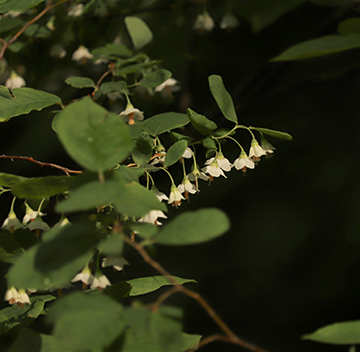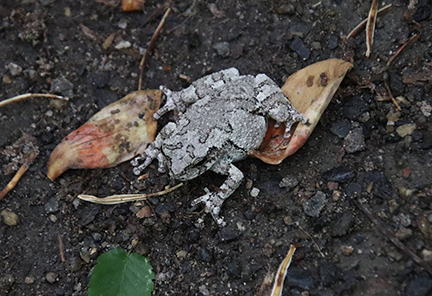Happy Mystery Monday! Can you guess what is pictured in photo below?

The answer to last week’s mystery is Copes gray treefrog, Hyla chrysoscelis, pictured below.

Cope’s gray tree frogs are native to North America, and are especially abundant in the southeast. They are adapted to woodland habitats but will sometimes travel into more open areas to reach a breeding pond. These frogs inhabit all elevations of wooded areas near temporary and permanent waters, such as swamps, ponds, lakes, old fields, thickly wooded suburban neighborhoods, farm woodlots, and mixed or deciduous forests.
Variable in color from mottled gray to gray green, the skin of Cope’s gray tree frogs resembles bark. They typically measure 3.2–5.1 cm long. As a member of the genus Hyla, they possess advanced toe pads, allowing them to adhere more strongly to vertical surfaces, like glass, metal, and primarily tree bark.
Cope’s grays rest in damp, rotten logs, or hollow trees, emerging to feed. Tree frogs tend to be “sit-and-wait” predators, consuming caterpillars, beetles, flies that wander by. Tree frogs produce mucus secretions that are foul tasting and cause burning sensation and inflammation. While these secretions are thought to be anti-predator functions, it is possible that they also function as antimicrobial agents.
In Winter, Cope’s gray tree frogs hibernate on land, and may be found under woody debris logs, roots and leaf litter. When gray tree frogs hibernate, they appear rigid. They have a high freezing tolerance due to glycerol in the blood. During hibernation, 80% of the body freezes and the eye becomes opaque as breathing and heartbeat are temporarily suspended. Their high tolerance for freezing temperatures has enabled gray tree frogs to expand their territory northward towards higher elevations. Cope’s gray tree frog can survive temperatures as low as 18°F.
Mystery Monday is sponsored by the Spy Newspapers and Adkins Arboretum.


Write a Letter to the Editor on this Article
We encourage readers to offer their point of view on this article by submitting the following form. Editing is sometimes necessary and is done at the discretion of the editorial staff.